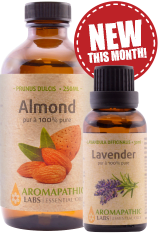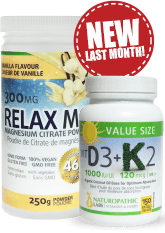- 100mg
- Angelica (angelicaarch-angelica) leaf extract (5:1)
Format
 Tablets
Tablets
30 Tabs
Dosage
Adult men: Take 2 tablets daily before bedtime
Important Information
Consult a health care practitioner prior to use if you have a peptic ulcer; if symptoms persist or worsen; and to exclude a diagnosis of prostate cancer. Avoid prolonged exposure to sunlight, ultraviolet light, or UV therapy.
- Helps people suffering from enuresis (bed-wetting)
- Reduces urinary frequency at night
- Helps people with an overactive bladder
- Has been clinically studied
- Supports prostate enlargement (BPH) in mature men
Related Videos
No Related VideosArticles by a naturopathic doctor.
Terry Naturally, formulators of popular Canadian natural health supplements, AnxioCalm to support stress and overall well being and Curapro optimum to support joint health. Terry Naturally follows good manufacturing and documentations practices and uses the highest quality ingredients to ensure quality, high potency products.
OVERACTIVE BLADDER
There are few things more frustrating than running to the bathroom only to pass a few drops of urine. Fortunately, this condition does not have to ruin your life…
The bladder is the hollow organ located in the lower front of the pelvis that is responsible for holding urine produced by the kidneys until we can find an appropriate time to urinate. In order to accommodate more urine as time passes, the bladder actually expands and stretches a little like a balloon.
The average person’s bladder can hold anywhere from 350 to 550ml of urine at any time, although the urge to urinate tends to occur at around 200ml of fluid. Normal urination occurs at around every 3-4hours in people with average fluid intake.
Overactive Bladder - Urge Incontinence
There are two major muscles involved in urination; the sphincter at the external end of the urethra must relax to allow the urine to pass, and an internal muscle is then responsible for squeezing the bladder to force out the urine. When these muscles contract or relax at the wrong times it can result in frequent strong urges to urinate, and even cause urine to leak out at unintended times. This is a condition known as urge incontinence, or more commonly known as overactive bladder. It is important to distinguish the urgency of overactive bladder from Urinary Incontinence, where urine leakage occurs due to activities that increase abdominal pressure like sneezing, or laughing.
Causes of Overactive Bladder
There are a number of potential causes of overactive bladder, some more serious and some that are very simple to treat. Common causes are: bladder inflammation, bladder stones, and bladder infection. Anything that blocks proper draining of the bladder can also cause overactive bladder, such as enlarged prostate, or urethral obstruction. More serious conditions are bladder cell growths and nervous system diseases (like Multiple Sclerosis) or nerve injuries (like a Stroke). Unfortunately, many cases of urge incontinence are of unknown cause, making this a difficult condition to treat.
Conventional Treatment
Medical doctors will most commonly treat overactive bladder with medications to help relax the bladder muscles to prevent the spasms that triggers urgency and leakage. Side effects of these medications include dry mouth, constipation, and glaucoma. Some doctors may instead recommend tricyclic antidepressants to prevent stimulation of the bladder walls. Side effects of these medications include: blurred vision, dizziness, dry mouth, fatigue, insomnia, and nausea. In severe cases, surgery may also be presented as an option.
Diet
Monitoring and managing your consumption of liquids can help reduce some symptoms. If your bladder is infected or irritated, drinking more water can help ease your bladder. Even if your bladder isn’t infected, drinking more water can help reduce urine odour in the case of leaking. Ensure that your water consumption is steady rather than all at once. Drinks that contain caffeine like coffee, tea and energy drinks will only further irritate your bladder. Some foods, namely acidic foods like citrus as well as spicy foods, would be beneficial to avoid. By maintaining a healthy weight and diet, urination frequency should be reduced.
Lifestyle
Be sure to get a diagnosis from a healthcare practitioner that rules out infection or bladder stones, to be sure you are covering all of your bases with treatment. A simple urinalysis can help to rule out other underlying problems and help target your treatments. Staying active can help you maintain a healthy weight and can promote a stronger pelvic floor. See the Kegel paragraph below for more information. Avoid irritating the urethra with harsh soaps, bubble baths, and friction from tight clothing. Wear breathable cotton underwear, and cotton sanitary pads if necessary to reduce bacterial growth in the area. Be sure to urinate after sex to help flush the urethra to prevent infection. Avoid squatting over the toilet, as many women do in public restrooms, as this can prevent complete emptying of the bladder, and reduce the time you have until your next urge. If you are concerned about hygiene simply use provided toilet seat covers or drape toilet paper over the seat. Sitting down will allow the bladder to drain completely. Check your medications to ensure that none of them have diuretic, or increased urination as a side effect. If they do, speak to your doctor about other alternatives. Acpuncture treatments have also been shown to help reduce the symptoms of overactive bladder.
Kegel Exercises
Kegel exercises and other means of strengthening the muscles of the pelvic floor can significantly improve the symptoms of overactive bladder. These exercises simply involve squeezing and lifting the vaginal and rectal muscles as though you are holding in urgent urine and/or stool. Hold this squeeze for 5-10 seconds each time without clenching your buttocks; Repeat 5 or more times daily. You can do them anywhere, and no one will have to know! Other options include vaginal weight training, where a small weight is held in the vagina for 15 minutes a few times a day to help tighten the pelvic floor. When these muscles become stronger, they help to prevent bladder leakage.
Sanitary Products
Often the use of sanitary pads or adult diapers is our biggest fear in aging, and people will avoid them at all cost. There’s a feeling of loss of dignity with loss of continence. This doesn’t have to be the case. Interestingly, we can use these devices as stop-gap measures while we deal with the underlying problem to get life back on track. One example of these measures is bladder retraining.
Bladder Retraining
We are born without the ability to control our bladder function. In infancy, our body simply releases urine when the bladder is filled with a certain amount of urine. This is the reason potty training is necessary in toddlers. Interestingly, we can actually use similar principles to retrain our bladder later in life. Over time, the bladder muscles can be retrained to hold urine for longer and longer periods of time. First it is necessary to become familiar with your current urination schedule so keep a journal of urination for the first week. Once you get a feel for your timing, set up your own urination schedule and stick to it. Start with a realistic amount of time for you based on your journal, such as 1 or 1.5hrs between trips to the washroom and practice holding your urine. Do not go to the washroom, even if urgency or bladder leakage occurs between your scheduled times (this is where sanitary products will come in handy). Over time, as you become better at holding your urine, you can gradually increase the time between trips by half an hour until you are urinating every 3 or 4 hours.
Supplements
The proper treatment of overactive bladder will always rely on an understanding of the underlying cause of the problem. There are a number of things that can help to reduce the symptoms, but the ultimate goal is always to fix the root of the problem, so the symptoms resolve naturally. There are a number of anti-spasmodic herbs that can help to reduce the smooth muscle spasms associated with overactive bladder. Butterbur in particular can help to reduce spasms in the urinary tract, and thus reduce the urgency and leaking associated with this condition. Supplementing Magnesium can also help to relax the smooth muscles of the bladder and prevent spasms. There are a number of herbs that can soothe bladder irritation such as: Marshmallow, and in men Saw Palmetto can help prevent BPH associated problems.
- Reviews
- POST A NEW REVIEW





















